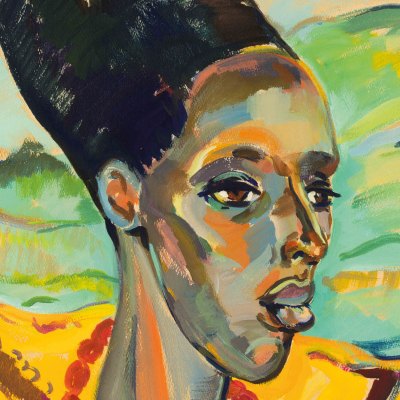Next month, England rugby star Maro Itoje dips his toes into the art world for the first time, presenting a group exhibition at Signature African Art gallery in London. ‘A History Untold’ (20 May–19 June) features work by six artists from Africa and the African diaspora – and is intended, Itoje has said, ‘to underline the importance of including more black history on the British national curriculum […], breaking down biases that currently exist’. Taking a break from training, Itoje tells Apollo how he became involved in the exhibition and how he balances his interests in art and politics with professional sport – and why he didn’t become a painter.
How did you get involved with this exhibition?
It’s probably best to start with where my interest in African art came from. I’m of Nigerian origin – both my parents were born in Nigeria – and because of the way I’ve been brought up, Nigeria is a massive part of my life and how I see the world.
When I moved into my first apartment in around 2015, I wanted to decorate it with some African art pieces. But being in London it was a struggle to find African art – I looked all around, but the art that I did find was either ridiculously expensive or inauthentic. So on my next trip to Nigeria later that year I went to some of the art markets in Lagos. I fell in love with the texture of the pieces, with the powerful imagery, the richness, the colour, the vibrancy of it all.
I’ve since bought works by local Nigerian artists, like Ola Hemzy, and I’ve always loved the idea of working with an art gallery. I came in contact with Signature African Art Gallery about a year or so ago, and we’ve just been building on this idea from then.
The show is about Black and African contributions to world culture, whether historical or contemporary. How important a subject is this for you?
I think it’s massively important. Often, through the media we consume – the images that we see on TV – there’s a single story depicted of Africa: one of poverty and deprivation. While I acknowledge that this is present within the continent, it’s also just one side of the coin. There are lots of other wonderful aspects of the continent that aren’t often portrayed. The point of this exhibition is to celebrate the contributions of Africans and people of African descent to the world.
Boshielo, Anaglyph (2020), Giggs Kgole. Courtesy Signature African Art

How closely have you been working with the artists?
We’ve worked with the artists to the extent of giving them the framework, the themes, the background of what we’re trying to create and the type of message that we’re trying to convey. But one thing I’ve learned is that that you don’t have to man-manage artists – really we’ve just left them to their own creative devices.
How do you balance your interests in politics and art with playing rugby?
Rugby is an integral part of my life. But I was Maro Itoje before I was a rugby player. While I’m very grateful and fortunate to be playing this beautiful game, there are other things that capture my mind and my imagination. I don’t see it as a conflict – I just see all the things I’m interested in intertwined.
How far does your interest in art go back? Were you a painter as a kid?
Well, my mum once bought me an art book that had works by the greater painters of the past – Vincent Van Gogh, Da Vinci – and for a brief period I wanted to be an artist. But when I finally put brush to paper I realised that painting wasn’t quite for me, to be honest. I didn’t have the knack or the skill – so I’ve settled for being an admirer!
Do you get out to galleries and museums much when you’re on tour?
Last time I went to South Africa, when we were based in Durban, there were a few art galleries I checked out – but I couldn’t go too far into the local street art markets because of rugby commitments. Wherever I am though, I always try and check out some of the local art. I went to Barbados in December and went to check out some of the Caribbean art. It was really interesting to see some of the similarities with African art – in terms of the themes, the inspirations behind the ways that artists put together their work.
Jealous Defender (2019), Steve Ekpenisi. Courtesy Signature African Art

Would you say that you’re the biggest art buff in the England squad?
I think I can categorically say I’m the biggest African art buff! Otherwise, I’m not really too sure – I haven’t been to all of their houses, so I haven’t seen what’s on their walls. But I guess I’m the one who’s the most vocal about it, at least.
So does a career in the art world beckon after rugby?
You know me, I’m never one to turn down a good opportunity. But I think just let’s wait and see; I’m the kind of person who’s very open to new experiences. To be honest, I might be trying for your job! Doesn’t sound too bad, spending your time going to galleries…
Courtesy Soapbox London

‘A History Untold’ is at Signature African Art, London, from 20 May–19 June.



